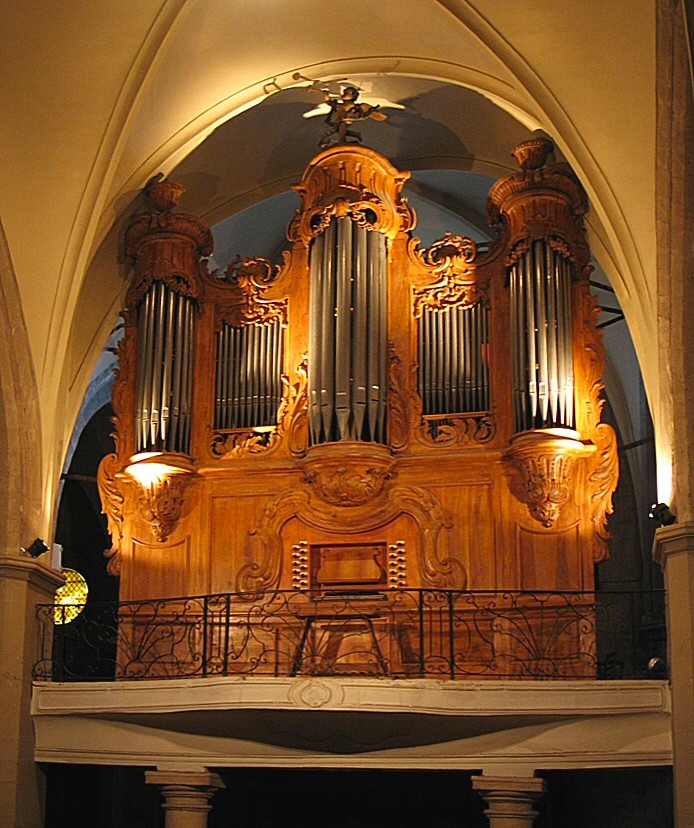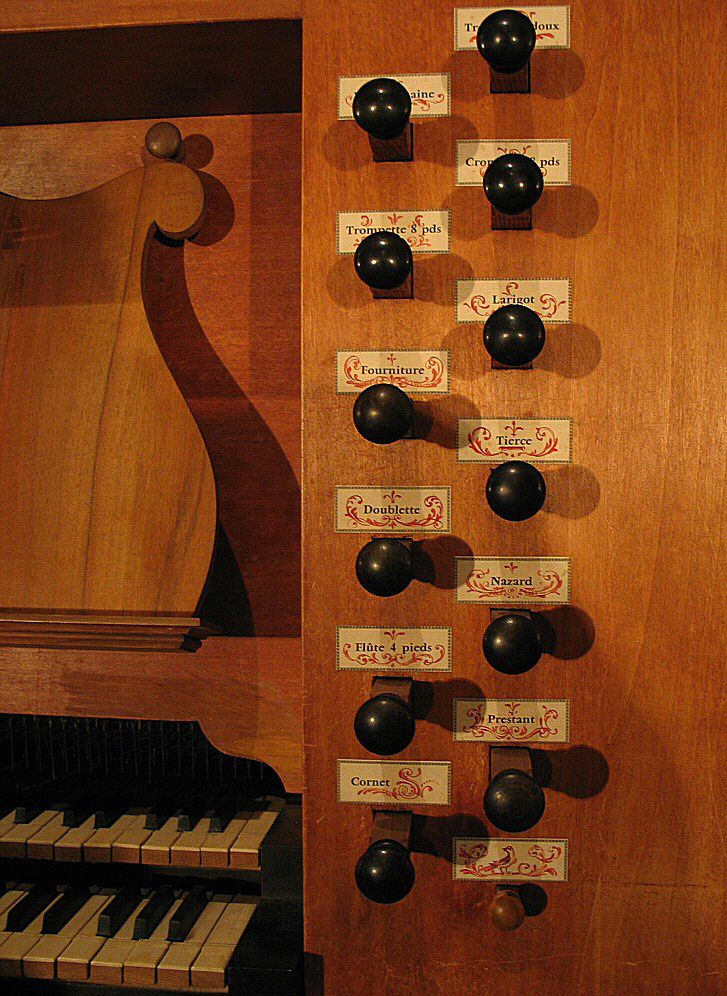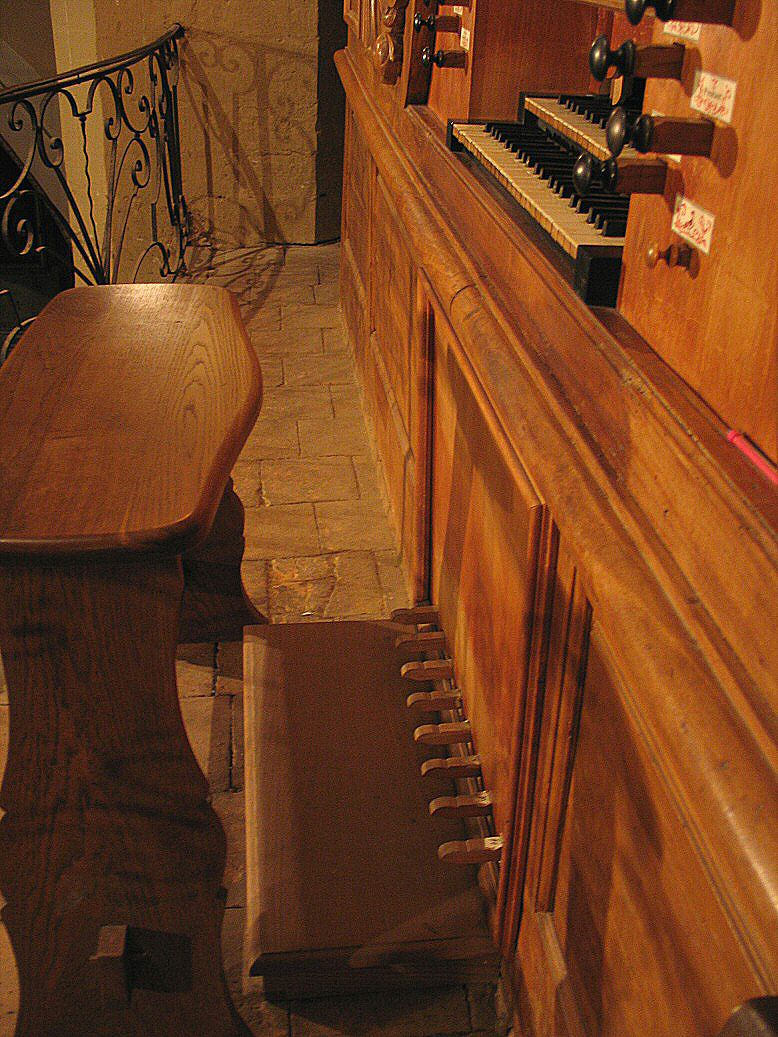Roquemaure, Église Collégiale et paroissiale Saint-Jean-Baptiste
| Builder | Frères Jullien |
|---|---|
| Year | 1690 |
| Period/Style | Baroque |
| Stops | 18 |
| Keyboards | 2+P |
| Keyaction | tracker/mechanical |
| Sampleset |
Available
 , sampled by
OrganArt Media
, sampled by
OrganArt Media
|
The 1690 Frères Jullien organ in the collegiate church of Saint Jean-Baptiste and Saint Jean l'Evangéliste in Roquemaure, Languedoc, France, is a historic and revered instrument. Originally built for the Cordeliers Church in Avignon, this organ was unknown until 1965 when documentation from the Cordeliers Monastery confirmed its provenance. Replacing an earlier 1642 organ destroyed during the French Revolution, it was sold as a national asset and eventually acquired by the Textile Committee of Roquemaure. Known for containing one of the most significant sets of 17th-century original pipes, the organ is a classified historical monument and has gained global fame through recordings made by master organists.
The organ’s design features a distinct Spanish style with separate wind chests for bass and treble, split manuals, and a modest pedalboard. Its construction includes medieval techniques, and its pipes, made of rolled metal in the Italian style, are exceptionally well-preserved. The organ's "Tierce" stop is unusually narrow, a rarity in 18th-century French organs. Powerful and characterful reed stops provide versatility, allowing performances of French, Spanish, and Italian Baroque music. Restored in 1988/89 by Atelier de Facture d'Orgues and Pascal Quiorin, and its case by Férignac, the organ remains in excellent condition. The church itself offers a moderate acoustic environment with about 3 seconds of reverberation, enhancing the organ’s rich historical and musical contributions.
The organ’s design features a distinct Spanish style with separate wind chests for bass and treble, split manuals, and a modest pedalboard. Its construction includes medieval techniques, and its pipes, made of rolled metal in the Italian style, are exceptionally well-preserved. The organ's "Tierce" stop is unusually narrow, a rarity in 18th-century French organs. Powerful and characterful reed stops provide versatility, allowing performances of French, Spanish, and Italian Baroque music. Restored in 1988/89 by Atelier de Facture d'Orgues and Pascal Quiorin, and its case by Férignac, the organ remains in excellent condition. The church itself offers a moderate acoustic environment with about 3 seconds of reverberation, enhancing the organ’s rich historical and musical contributions.
| Grand Orgue | Récit | Pedal (always attached to GO) |
|---|---|---|
| Montre 8 | Bourdon 8 et Flûte 4 (permanents) | Basse (permanente) |
| Bourdon 8 | Cornet 3rangs | Bombarde 16 |
| Prestant 4 | ||
| Flûte 4 (basses et dessus) | ||
| Nazard 2 2/3 (basses et dessus) | ||
| Doublette 2 (basses et dessus) | ||
| Tierce 1 3/5 (basses et dessus) | ||
| Larigot 1 1/3 (basses et dessus) | ||
| Fourniture 3 rangs | ||
| Cymbale 3 rangs | ||
| Trompette 8 (basses et dessus) | ||
| Cromorne 8' (basses et dessus) | ||
| Voix humaine 8' (basses et dessus) | ||
| Cornet 5 rangs (dessus) |
Cabanillas-Tiento de batalla Part 1
0:00
0:00
Dandrieu-Magnificat 16 Dialogue
0:00
0:00
Dandrieu-Magnificat 12 Duett
0:00
0:00
Dandrieu-Magnificat 11 Plein Jeu
0:00
0:00
Dandrieu-Magnificat 14 Basse de Trompette
0:00
0:00
https://www.organartmedia.com/de/freres-jullien
 Pipe Organ Map
Pipe Organ Map

